SBLC5001 - Highland Explore Tours: IS Implementation Case Study
VerifiedAdded on 2023/06/09
|15
|3559
|321
Case Study
AI Summary
This case study analyzes the implementation of an Information System (IS) for Highland Explore Tours, a travel and tourism company aiming to automate its booking processes. The study includes a project plan with a network diagram detailing task dependencies, timelines, and costs. It critically discusses reasons for project failure, such as not using specific project development methodologies, planning projects backward, failing to develop proper data models, lacking technical experience, coder, and system tester shortages, and poor communication. Furthermore, the case study outlines project success and failure criteria, emphasizing the importance of team development, scheduling, budget adherence, and the five project phases: initiation, planning, execution, control, and closure. The original document is contributed by a student and is available on Desklib, a platform offering AI-based study tools and resources for students.

Running head: IMPLEMENTATION OF INFORMATION SYSTEM
Assessment Component 1- Case study/individual essay
Implementation of Information System for Highland Explore Tours
Student name:
ID number:
Name of the University:
Assessment Component 1- Case study/individual essay
Implementation of Information System for Highland Explore Tours
Student name:
ID number:
Name of the University:
Paraphrase This Document
Need a fresh take? Get an instant paraphrase of this document with our AI Paraphraser
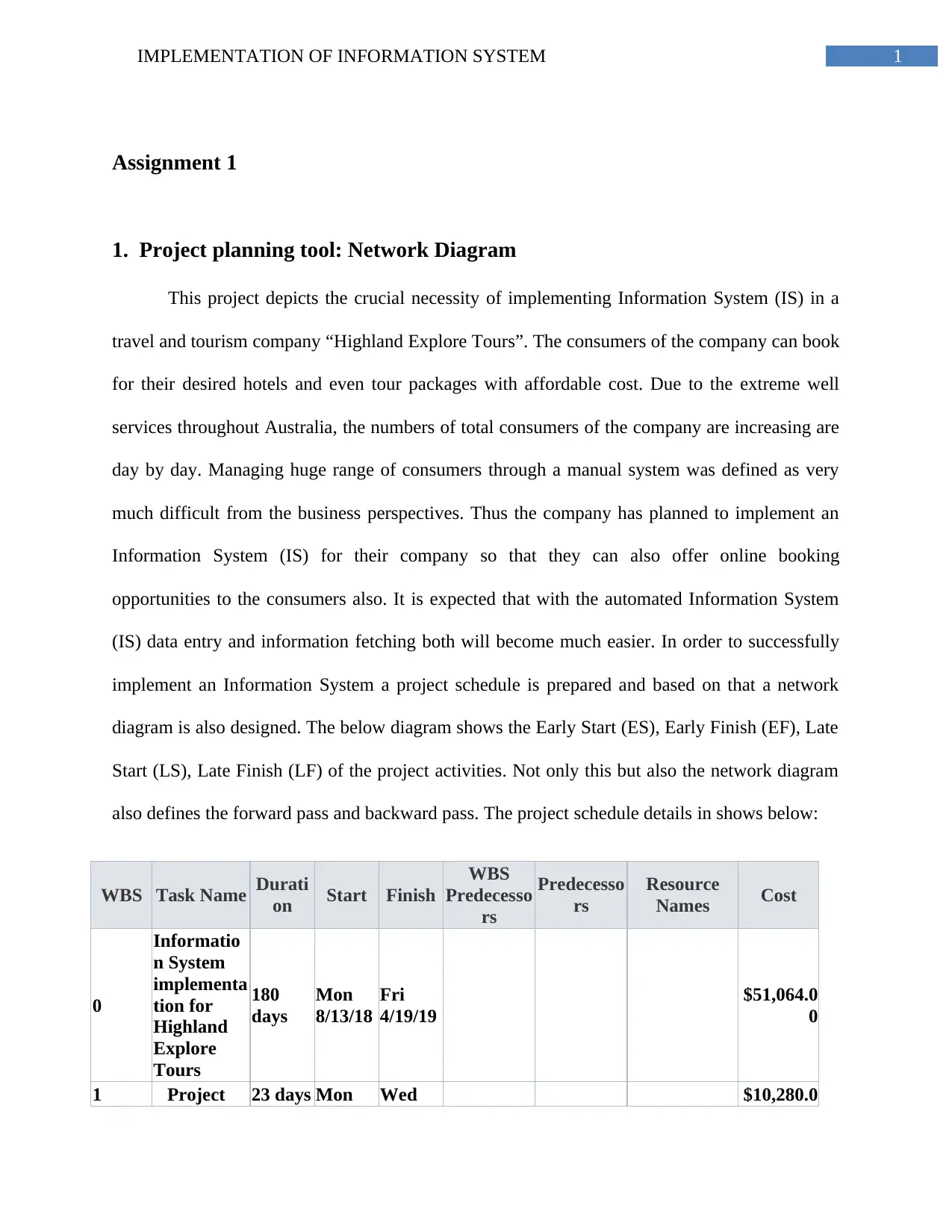
1IMPLEMENTATION OF INFORMATION SYSTEM
Assignment 1
1. Project planning tool: Network Diagram
This project depicts the crucial necessity of implementing Information System (IS) in a
travel and tourism company “Highland Explore Tours”. The consumers of the company can book
for their desired hotels and even tour packages with affordable cost. Due to the extreme well
services throughout Australia, the numbers of total consumers of the company are increasing are
day by day. Managing huge range of consumers through a manual system was defined as very
much difficult from the business perspectives. Thus the company has planned to implement an
Information System (IS) for their company so that they can also offer online booking
opportunities to the consumers also. It is expected that with the automated Information System
(IS) data entry and information fetching both will become much easier. In order to successfully
implement an Information System a project schedule is prepared and based on that a network
diagram is also designed. The below diagram shows the Early Start (ES), Early Finish (EF), Late
Start (LS), Late Finish (LF) of the project activities. Not only this but also the network diagram
also defines the forward pass and backward pass. The project schedule details in shows below:
WBS Task Name Durati
on Start Finish
WBS
Predecesso
rs
Predecesso
rs
Resource
Names Cost
0
Informatio
n System
implementa
tion for
Highland
Explore
Tours
180
days
Mon
8/13/18
Fri
4/19/19
$51,064.0
0
1 Project 23 days Mon Wed $10,280.0
Assignment 1
1. Project planning tool: Network Diagram
This project depicts the crucial necessity of implementing Information System (IS) in a
travel and tourism company “Highland Explore Tours”. The consumers of the company can book
for their desired hotels and even tour packages with affordable cost. Due to the extreme well
services throughout Australia, the numbers of total consumers of the company are increasing are
day by day. Managing huge range of consumers through a manual system was defined as very
much difficult from the business perspectives. Thus the company has planned to implement an
Information System (IS) for their company so that they can also offer online booking
opportunities to the consumers also. It is expected that with the automated Information System
(IS) data entry and information fetching both will become much easier. In order to successfully
implement an Information System a project schedule is prepared and based on that a network
diagram is also designed. The below diagram shows the Early Start (ES), Early Finish (EF), Late
Start (LS), Late Finish (LF) of the project activities. Not only this but also the network diagram
also defines the forward pass and backward pass. The project schedule details in shows below:
WBS Task Name Durati
on Start Finish
WBS
Predecesso
rs
Predecesso
rs
Resource
Names Cost
0
Informatio
n System
implementa
tion for
Highland
Explore
Tours
180
days
Mon
8/13/18
Fri
4/19/19
$51,064.0
0
1 Project 23 days Mon Wed $10,280.0

2IMPLEMENTATION OF INFORMATION SYSTEM
initiation
phase 8/13/18 9/12/18 0
A Defining
project goal 3 days Mon
8/13/18
Wed
8/15/18
Project
manager $720.00
B
Setting
project
priority
5 days Thu
8/16/18
Wed
8/22/18 A 2 business
analyst $1,400.00
C Requiremen
t gathering
6 days Thu
8/23/18
Thu
8/30/18 B 3 operation
manager $1,824.00
D Requiremen
t analysis
6 days Thu
8/23/18
Thu
8/30/18 B 3 business
analyst $1,680.00
E Developing
business
strategies
8 days Fri
8/31/18
Tue
9/11/18 C 4 Project
manager $1,920.00
F
Arrangemen
t of meeting
for
developing
project team
9 days Fri
8/31/18
Wed
9/12/18 D,C 5,4 operation
manager $2,736.00
2
Project
planning
phase
51 days Wed
9/12/18
Wed
11/21/1
8
$12,752.0
0
G Functional
requirement
s gathering
8 days Wed
9/12/18
Fri
9/21/18 E 6 finance
manager $1,600.00
H
Non
functional
requirement
s
identificatio
n
6 days Mon
9/24/18
Mon
10/1/18 G 9 business
analyst $1,680.00
I
Defining
work
processes
5 days Tue
10/2/18
Mon
10/8/18 H 10 finance
manager $1,000.00
J Hardware
requirement
s gathering
6 days Tue
10/9/18
Tue
10/16/1
8
I 11 operation
manager $1,824.00
K Software
requirement
6 days Wed
10/17/1
Wed
10/24/1
J 12 Project
manager
$1,440.00
initiation
phase 8/13/18 9/12/18 0
A Defining
project goal 3 days Mon
8/13/18
Wed
8/15/18
Project
manager $720.00
B
Setting
project
priority
5 days Thu
8/16/18
Wed
8/22/18 A 2 business
analyst $1,400.00
C Requiremen
t gathering
6 days Thu
8/23/18
Thu
8/30/18 B 3 operation
manager $1,824.00
D Requiremen
t analysis
6 days Thu
8/23/18
Thu
8/30/18 B 3 business
analyst $1,680.00
E Developing
business
strategies
8 days Fri
8/31/18
Tue
9/11/18 C 4 Project
manager $1,920.00
F
Arrangemen
t of meeting
for
developing
project team
9 days Fri
8/31/18
Wed
9/12/18 D,C 5,4 operation
manager $2,736.00
2
Project
planning
phase
51 days Wed
9/12/18
Wed
11/21/1
8
$12,752.0
0
G Functional
requirement
s gathering
8 days Wed
9/12/18
Fri
9/21/18 E 6 finance
manager $1,600.00
H
Non
functional
requirement
s
identificatio
n
6 days Mon
9/24/18
Mon
10/1/18 G 9 business
analyst $1,680.00
I
Defining
work
processes
5 days Tue
10/2/18
Mon
10/8/18 H 10 finance
manager $1,000.00
J Hardware
requirement
s gathering
6 days Tue
10/9/18
Tue
10/16/1
8
I 11 operation
manager $1,824.00
K Software
requirement
6 days Wed
10/17/1
Wed
10/24/1
J 12 Project
manager
$1,440.00
⊘ This is a preview!⊘
Do you want full access?
Subscribe today to unlock all pages.

Trusted by 1+ million students worldwide

3IMPLEMENTATION OF INFORMATION SYSTEM
s gathering 8 8
L Preparing
project
budget
7 days
Thu
10/25/1
8
Fri
11/2/18 K 13 finance
manager $1,400.00
M Stakeholder
management
planning
7 days Mon
11/5/18
Tue
11/13/1
8
L 14 operation
manager $2,128.00
N
Risk
matrix
developmen
t
6 days
Wed
11/14/1
8
Wed
11/21/1
8
M 15 business
analyst $1,680.00
3 Execution
phase 52 days
Thu
11/22/1
8
Fri
2/1/19
$12,976.0
0
O Prototype
designing
10 days
Thu
11/22/1
8
Wed
12/5/18 N 16
analyst,
system
developer
$4,480.00
P Simulation 12 days Thu
12/6/18
Fri
12/21/1
8
N,O 16,18 coder $2,112.00
Q
Application
programmin
g and
modeling
14 days
Mon
12/24/1
8
Thu
1/10/19 P 19 programmer $2,800.00
R
Final
design
handover
16 days Fri
1/11/19
Fri
2/1/19 Q 20 system
developer $3,584.00
4
Project
control
phase
32 days Mon
2/4/19
Tue
3/19/19 $9,152.00
S Unit
testing 12 days Mon
2/4/19
Tue
2/19/19 R 21 coder $2,112.00
T Integrated
testing
10 days Wed
2/20/19
Tue
3/5/19 S 23 system
developer $2,240.00
U Acceptance
testing
10 days Wed
3/6/19
Tue
3/19/19 T 24
coder,
operation
manager
$4,800.00
5 Closure
phase 23 days Wed
3/20/19
Fri
4/19/19 $5,904.00
V 6 days Wed Wed U 25 operation $1,824.00
s gathering 8 8
L Preparing
project
budget
7 days
Thu
10/25/1
8
Fri
11/2/18 K 13 finance
manager $1,400.00
M Stakeholder
management
planning
7 days Mon
11/5/18
Tue
11/13/1
8
L 14 operation
manager $2,128.00
N
Risk
matrix
developmen
t
6 days
Wed
11/14/1
8
Wed
11/21/1
8
M 15 business
analyst $1,680.00
3 Execution
phase 52 days
Thu
11/22/1
8
Fri
2/1/19
$12,976.0
0
O Prototype
designing
10 days
Thu
11/22/1
8
Wed
12/5/18 N 16
analyst,
system
developer
$4,480.00
P Simulation 12 days Thu
12/6/18
Fri
12/21/1
8
N,O 16,18 coder $2,112.00
Q
Application
programmin
g and
modeling
14 days
Mon
12/24/1
8
Thu
1/10/19 P 19 programmer $2,800.00
R
Final
design
handover
16 days Fri
1/11/19
Fri
2/1/19 Q 20 system
developer $3,584.00
4
Project
control
phase
32 days Mon
2/4/19
Tue
3/19/19 $9,152.00
S Unit
testing 12 days Mon
2/4/19
Tue
2/19/19 R 21 coder $2,112.00
T Integrated
testing
10 days Wed
2/20/19
Tue
3/5/19 S 23 system
developer $2,240.00
U Acceptance
testing
10 days Wed
3/6/19
Tue
3/19/19 T 24
coder,
operation
manager
$4,800.00
5 Closure
phase 23 days Wed
3/20/19
Fri
4/19/19 $5,904.00
V 6 days Wed Wed U 25 operation $1,824.00
Paraphrase This Document
Need a fresh take? Get an instant paraphrase of this document with our AI Paraphraser
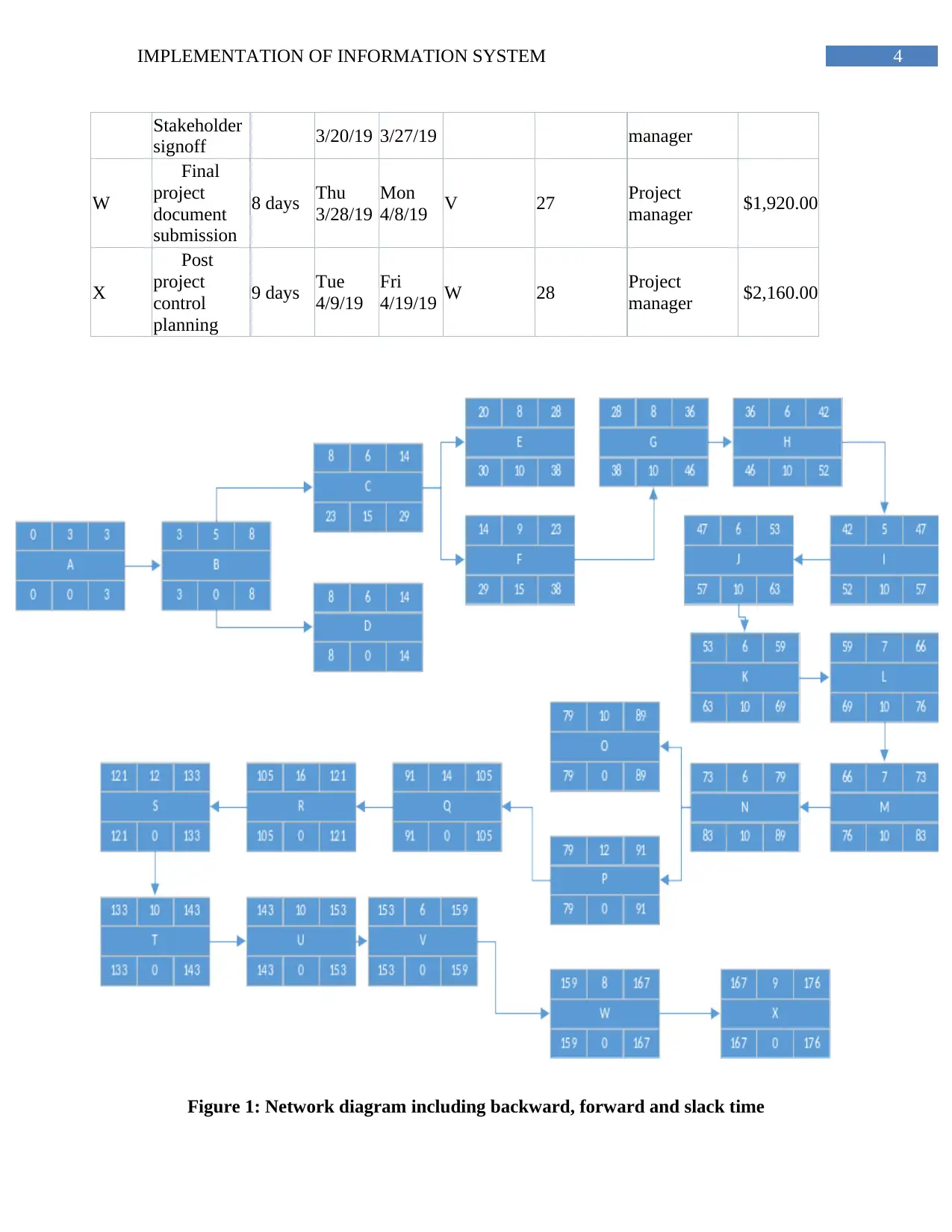
4IMPLEMENTATION OF INFORMATION SYSTEM
Stakeholder
signoff 3/20/19 3/27/19 manager
W
Final
project
document
submission
8 days Thu
3/28/19
Mon
4/8/19 V 27 Project
manager $1,920.00
X
Post
project
control
planning
9 days Tue
4/9/19
Fri
4/19/19 W 28 Project
manager $2,160.00
Figure 1: Network diagram including backward, forward and slack time
Stakeholder
signoff 3/20/19 3/27/19 manager
W
Final
project
document
submission
8 days Thu
3/28/19
Mon
4/8/19 V 27 Project
manager $1,920.00
X
Post
project
control
planning
9 days Tue
4/9/19
Fri
4/19/19 W 28 Project
manager $2,160.00
Figure 1: Network diagram including backward, forward and slack time
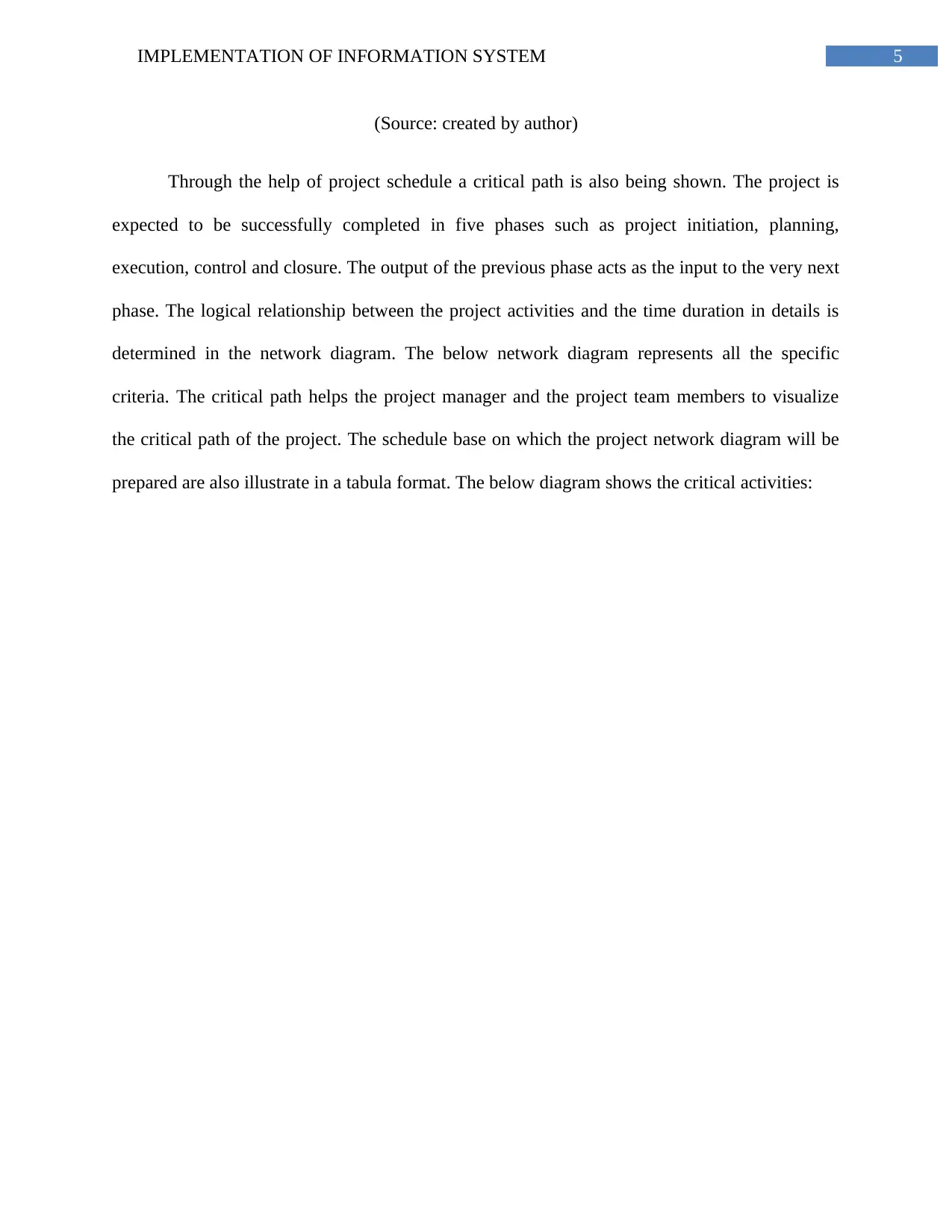
5IMPLEMENTATION OF INFORMATION SYSTEM
(Source: created by author)
Through the help of project schedule a critical path is also being shown. The project is
expected to be successfully completed in five phases such as project initiation, planning,
execution, control and closure. The output of the previous phase acts as the input to the very next
phase. The logical relationship between the project activities and the time duration in details is
determined in the network diagram. The below network diagram represents all the specific
criteria. The critical path helps the project manager and the project team members to visualize
the critical path of the project. The schedule base on which the project network diagram will be
prepared are also illustrate in a tabula format. The below diagram shows the critical activities:
(Source: created by author)
Through the help of project schedule a critical path is also being shown. The project is
expected to be successfully completed in five phases such as project initiation, planning,
execution, control and closure. The output of the previous phase acts as the input to the very next
phase. The logical relationship between the project activities and the time duration in details is
determined in the network diagram. The below network diagram represents all the specific
criteria. The critical path helps the project manager and the project team members to visualize
the critical path of the project. The schedule base on which the project network diagram will be
prepared are also illustrate in a tabula format. The below diagram shows the critical activities:
⊘ This is a preview!⊘
Do you want full access?
Subscribe today to unlock all pages.

Trusted by 1+ million students worldwide
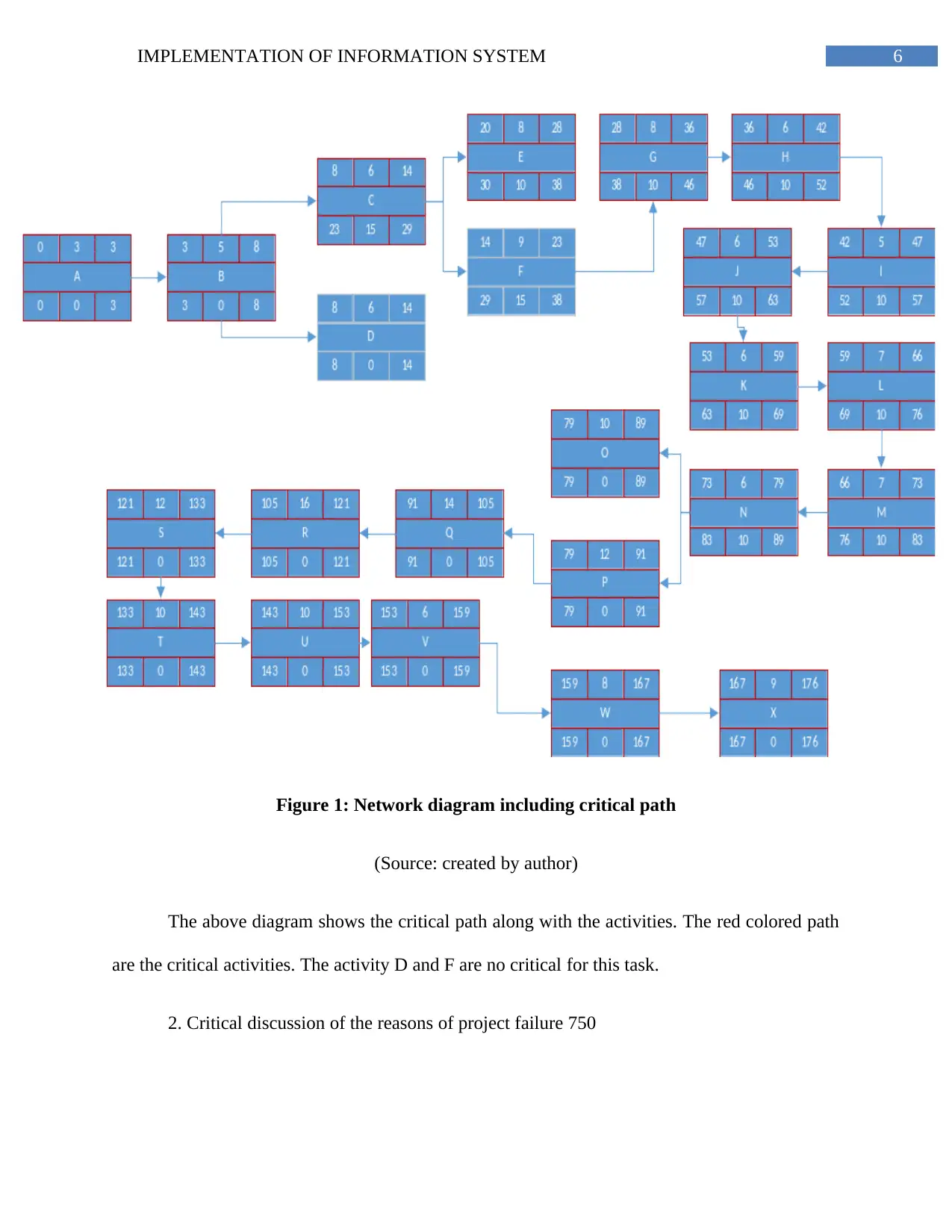
6IMPLEMENTATION OF INFORMATION SYSTEM
Figure 1: Network diagram including critical path
(Source: created by author)
The above diagram shows the critical path along with the activities. The red colored path
are the critical activities. The activity D and F are no critical for this task.
2. Critical discussion of the reasons of project failure 750
Figure 1: Network diagram including critical path
(Source: created by author)
The above diagram shows the critical path along with the activities. The red colored path
are the critical activities. The activity D and F are no critical for this task.
2. Critical discussion of the reasons of project failure 750
Paraphrase This Document
Need a fresh take? Get an instant paraphrase of this document with our AI Paraphraser
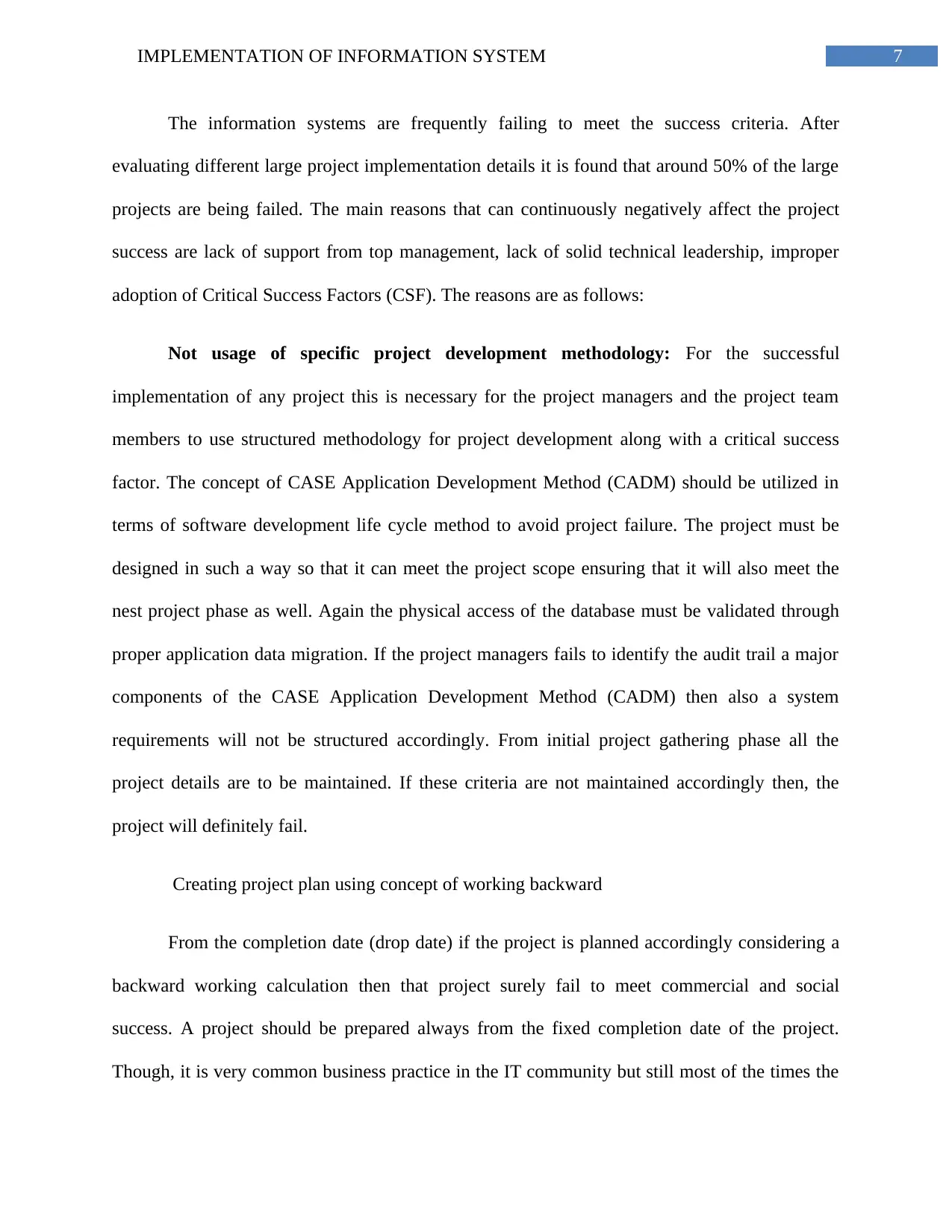
7IMPLEMENTATION OF INFORMATION SYSTEM
The information systems are frequently failing to meet the success criteria. After
evaluating different large project implementation details it is found that around 50% of the large
projects are being failed. The main reasons that can continuously negatively affect the project
success are lack of support from top management, lack of solid technical leadership, improper
adoption of Critical Success Factors (CSF). The reasons are as follows:
Not usage of specific project development methodology: For the successful
implementation of any project this is necessary for the project managers and the project team
members to use structured methodology for project development along with a critical success
factor. The concept of CASE Application Development Method (CADM) should be utilized in
terms of software development life cycle method to avoid project failure. The project must be
designed in such a way so that it can meet the project scope ensuring that it will also meet the
nest project phase as well. Again the physical access of the database must be validated through
proper application data migration. If the project managers fails to identify the audit trail a major
components of the CASE Application Development Method (CADM) then also a system
requirements will not be structured accordingly. From initial project gathering phase all the
project details are to be maintained. If these criteria are not maintained accordingly then, the
project will definitely fail.
Creating project plan using concept of working backward
From the completion date (drop date) if the project is planned accordingly considering a
backward working calculation then that project surely fail to meet commercial and social
success. A project should be prepared always from the fixed completion date of the project.
Though, it is very common business practice in the IT community but still most of the times the
The information systems are frequently failing to meet the success criteria. After
evaluating different large project implementation details it is found that around 50% of the large
projects are being failed. The main reasons that can continuously negatively affect the project
success are lack of support from top management, lack of solid technical leadership, improper
adoption of Critical Success Factors (CSF). The reasons are as follows:
Not usage of specific project development methodology: For the successful
implementation of any project this is necessary for the project managers and the project team
members to use structured methodology for project development along with a critical success
factor. The concept of CASE Application Development Method (CADM) should be utilized in
terms of software development life cycle method to avoid project failure. The project must be
designed in such a way so that it can meet the project scope ensuring that it will also meet the
nest project phase as well. Again the physical access of the database must be validated through
proper application data migration. If the project managers fails to identify the audit trail a major
components of the CASE Application Development Method (CADM) then also a system
requirements will not be structured accordingly. From initial project gathering phase all the
project details are to be maintained. If these criteria are not maintained accordingly then, the
project will definitely fail.
Creating project plan using concept of working backward
From the completion date (drop date) if the project is planned accordingly considering a
backward working calculation then that project surely fail to meet commercial and social
success. A project should be prepared always from the fixed completion date of the project.
Though, it is very common business practice in the IT community but still most of the times the
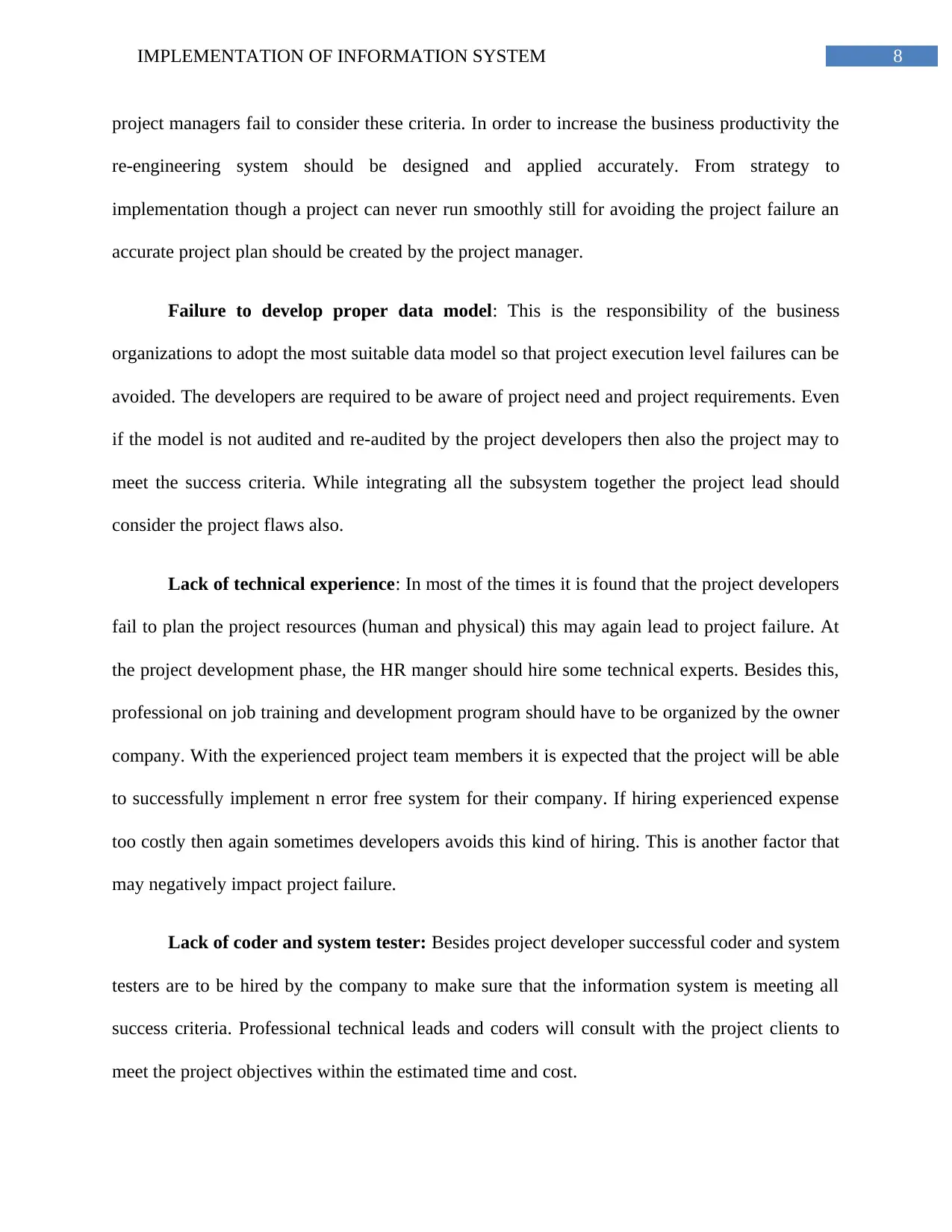
8IMPLEMENTATION OF INFORMATION SYSTEM
project managers fail to consider these criteria. In order to increase the business productivity the
re-engineering system should be designed and applied accurately. From strategy to
implementation though a project can never run smoothly still for avoiding the project failure an
accurate project plan should be created by the project manager.
Failure to develop proper data model: This is the responsibility of the business
organizations to adopt the most suitable data model so that project execution level failures can be
avoided. The developers are required to be aware of project need and project requirements. Even
if the model is not audited and re-audited by the project developers then also the project may to
meet the success criteria. While integrating all the subsystem together the project lead should
consider the project flaws also.
Lack of technical experience: In most of the times it is found that the project developers
fail to plan the project resources (human and physical) this may again lead to project failure. At
the project development phase, the HR manger should hire some technical experts. Besides this,
professional on job training and development program should have to be organized by the owner
company. With the experienced project team members it is expected that the project will be able
to successfully implement n error free system for their company. If hiring experienced expense
too costly then again sometimes developers avoids this kind of hiring. This is another factor that
may negatively impact project failure.
Lack of coder and system tester: Besides project developer successful coder and system
testers are to be hired by the company to make sure that the information system is meeting all
success criteria. Professional technical leads and coders will consult with the project clients to
meet the project objectives within the estimated time and cost.
project managers fail to consider these criteria. In order to increase the business productivity the
re-engineering system should be designed and applied accurately. From strategy to
implementation though a project can never run smoothly still for avoiding the project failure an
accurate project plan should be created by the project manager.
Failure to develop proper data model: This is the responsibility of the business
organizations to adopt the most suitable data model so that project execution level failures can be
avoided. The developers are required to be aware of project need and project requirements. Even
if the model is not audited and re-audited by the project developers then also the project may to
meet the success criteria. While integrating all the subsystem together the project lead should
consider the project flaws also.
Lack of technical experience: In most of the times it is found that the project developers
fail to plan the project resources (human and physical) this may again lead to project failure. At
the project development phase, the HR manger should hire some technical experts. Besides this,
professional on job training and development program should have to be organized by the owner
company. With the experienced project team members it is expected that the project will be able
to successfully implement n error free system for their company. If hiring experienced expense
too costly then again sometimes developers avoids this kind of hiring. This is another factor that
may negatively impact project failure.
Lack of coder and system tester: Besides project developer successful coder and system
testers are to be hired by the company to make sure that the information system is meeting all
success criteria. Professional technical leads and coders will consult with the project clients to
meet the project objectives within the estimated time and cost.
⊘ This is a preview!⊘
Do you want full access?
Subscribe today to unlock all pages.

Trusted by 1+ million students worldwide

9IMPLEMENTATION OF INFORMATION SYSTEM
Lack of communication: It is not necessary that every time a project will contain team
members from a different cultural and social background. Therefore in the workplace also an
internal communication gap and error may take place. It is the role of the owner company to
design rules and policy bench mark. On the other hand, it is the responsibility of the
responsibility to follow the standard rules and norms positively to avoid both inter organizational
and intra organizational communication. Scope is the main component that is needed by the
project heads conversely. If the project member fails to figure out the project details then an
entire project will be a failure. In order to avoid intra organizational failure, open communication
is the only approach that has to be followed by the project manager and project team member.
3. Project success and failure criteria
From past few organizational business background analyses it has been determined that
the track records for the overall usage of the information technology for implementing the
information systems are being terrible. Among all the information system based projects only
around 16.2% of projects are finished as successful one. Traditionally, Highland Explore Tours
has a paper based rather manual data management systems through which management of data
were quite difficult. Not only are these but also around 31% project cancelled before its
completion. The reasons for which most of the times project fails instead of meeting the success
criteria are defined through different valuable factors.
In order to implement information system in Highland Explore Tours it is necessary for
the company to develop a professional team and schedule as well. The project manager and the
allotted team members are allowed to play their job roles within the estimated time and budget as
well. The total budget that has been estimated for the information system implement project is
Lack of communication: It is not necessary that every time a project will contain team
members from a different cultural and social background. Therefore in the workplace also an
internal communication gap and error may take place. It is the role of the owner company to
design rules and policy bench mark. On the other hand, it is the responsibility of the
responsibility to follow the standard rules and norms positively to avoid both inter organizational
and intra organizational communication. Scope is the main component that is needed by the
project heads conversely. If the project member fails to figure out the project details then an
entire project will be a failure. In order to avoid intra organizational failure, open communication
is the only approach that has to be followed by the project manager and project team member.
3. Project success and failure criteria
From past few organizational business background analyses it has been determined that
the track records for the overall usage of the information technology for implementing the
information systems are being terrible. Among all the information system based projects only
around 16.2% of projects are finished as successful one. Traditionally, Highland Explore Tours
has a paper based rather manual data management systems through which management of data
were quite difficult. Not only are these but also around 31% project cancelled before its
completion. The reasons for which most of the times project fails instead of meeting the success
criteria are defined through different valuable factors.
In order to implement information system in Highland Explore Tours it is necessary for
the company to develop a professional team and schedule as well. The project manager and the
allotted team members are allowed to play their job roles within the estimated time and budget as
well. The total budget that has been estimated for the information system implement project is
Paraphrase This Document
Need a fresh take? Get an instant paraphrase of this document with our AI Paraphraser
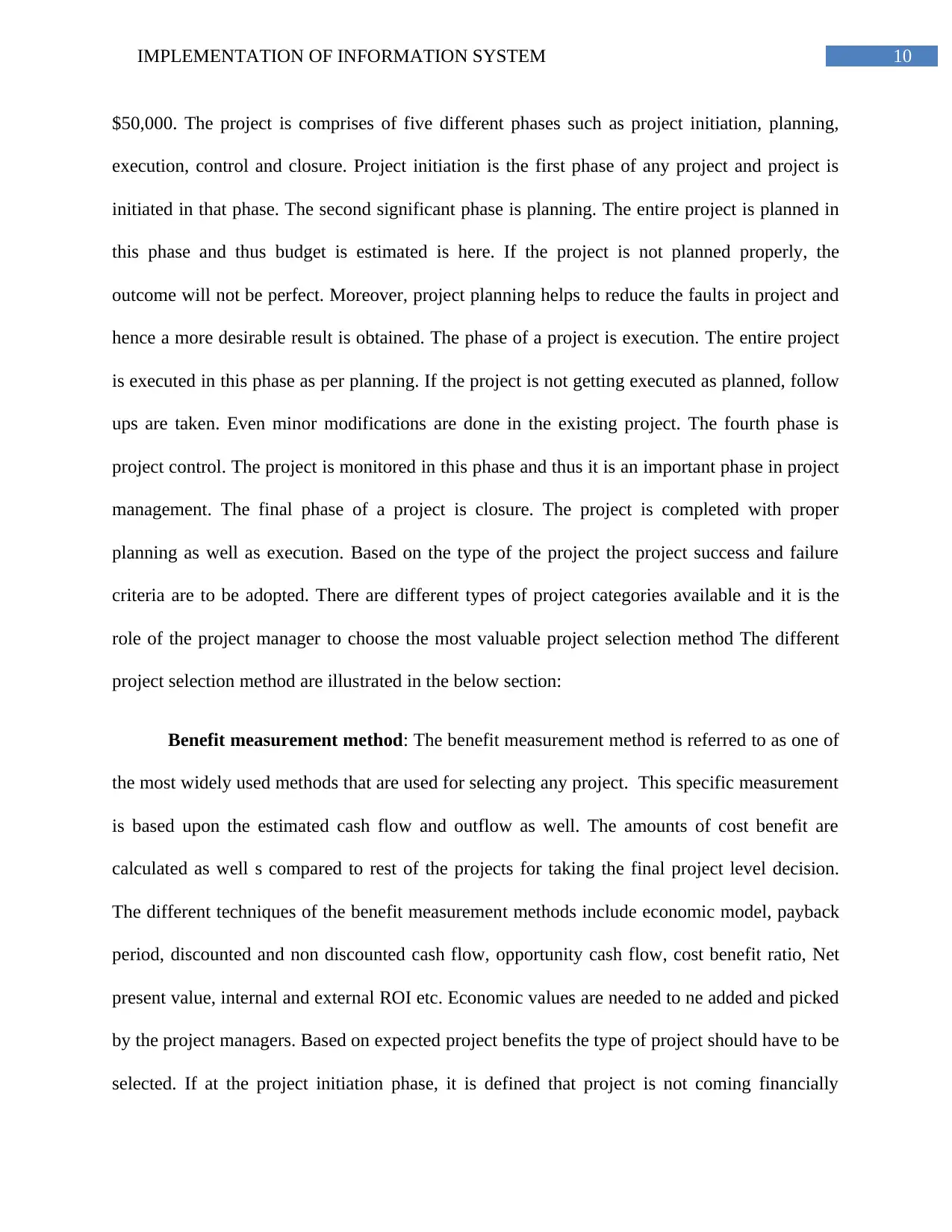
10IMPLEMENTATION OF INFORMATION SYSTEM
$50,000. The project is comprises of five different phases such as project initiation, planning,
execution, control and closure. Project initiation is the first phase of any project and project is
initiated in that phase. The second significant phase is planning. The entire project is planned in
this phase and thus budget is estimated is here. If the project is not planned properly, the
outcome will not be perfect. Moreover, project planning helps to reduce the faults in project and
hence a more desirable result is obtained. The phase of a project is execution. The entire project
is executed in this phase as per planning. If the project is not getting executed as planned, follow
ups are taken. Even minor modifications are done in the existing project. The fourth phase is
project control. The project is monitored in this phase and thus it is an important phase in project
management. The final phase of a project is closure. The project is completed with proper
planning as well as execution. Based on the type of the project the project success and failure
criteria are to be adopted. There are different types of project categories available and it is the
role of the project manager to choose the most valuable project selection method The different
project selection method are illustrated in the below section:
Benefit measurement method: The benefit measurement method is referred to as one of
the most widely used methods that are used for selecting any project. This specific measurement
is based upon the estimated cash flow and outflow as well. The amounts of cost benefit are
calculated as well s compared to rest of the projects for taking the final project level decision.
The different techniques of the benefit measurement methods include economic model, payback
period, discounted and non discounted cash flow, opportunity cash flow, cost benefit ratio, Net
present value, internal and external ROI etc. Economic values are needed to ne added and picked
by the project managers. Based on expected project benefits the type of project should have to be
selected. If at the project initiation phase, it is defined that project is not coming financially
$50,000. The project is comprises of five different phases such as project initiation, planning,
execution, control and closure. Project initiation is the first phase of any project and project is
initiated in that phase. The second significant phase is planning. The entire project is planned in
this phase and thus budget is estimated is here. If the project is not planned properly, the
outcome will not be perfect. Moreover, project planning helps to reduce the faults in project and
hence a more desirable result is obtained. The phase of a project is execution. The entire project
is executed in this phase as per planning. If the project is not getting executed as planned, follow
ups are taken. Even minor modifications are done in the existing project. The fourth phase is
project control. The project is monitored in this phase and thus it is an important phase in project
management. The final phase of a project is closure. The project is completed with proper
planning as well as execution. Based on the type of the project the project success and failure
criteria are to be adopted. There are different types of project categories available and it is the
role of the project manager to choose the most valuable project selection method The different
project selection method are illustrated in the below section:
Benefit measurement method: The benefit measurement method is referred to as one of
the most widely used methods that are used for selecting any project. This specific measurement
is based upon the estimated cash flow and outflow as well. The amounts of cost benefit are
calculated as well s compared to rest of the projects for taking the final project level decision.
The different techniques of the benefit measurement methods include economic model, payback
period, discounted and non discounted cash flow, opportunity cash flow, cost benefit ratio, Net
present value, internal and external ROI etc. Economic values are needed to ne added and picked
by the project managers. Based on expected project benefits the type of project should have to be
selected. If at the project initiation phase, it is defined that project is not coming financially
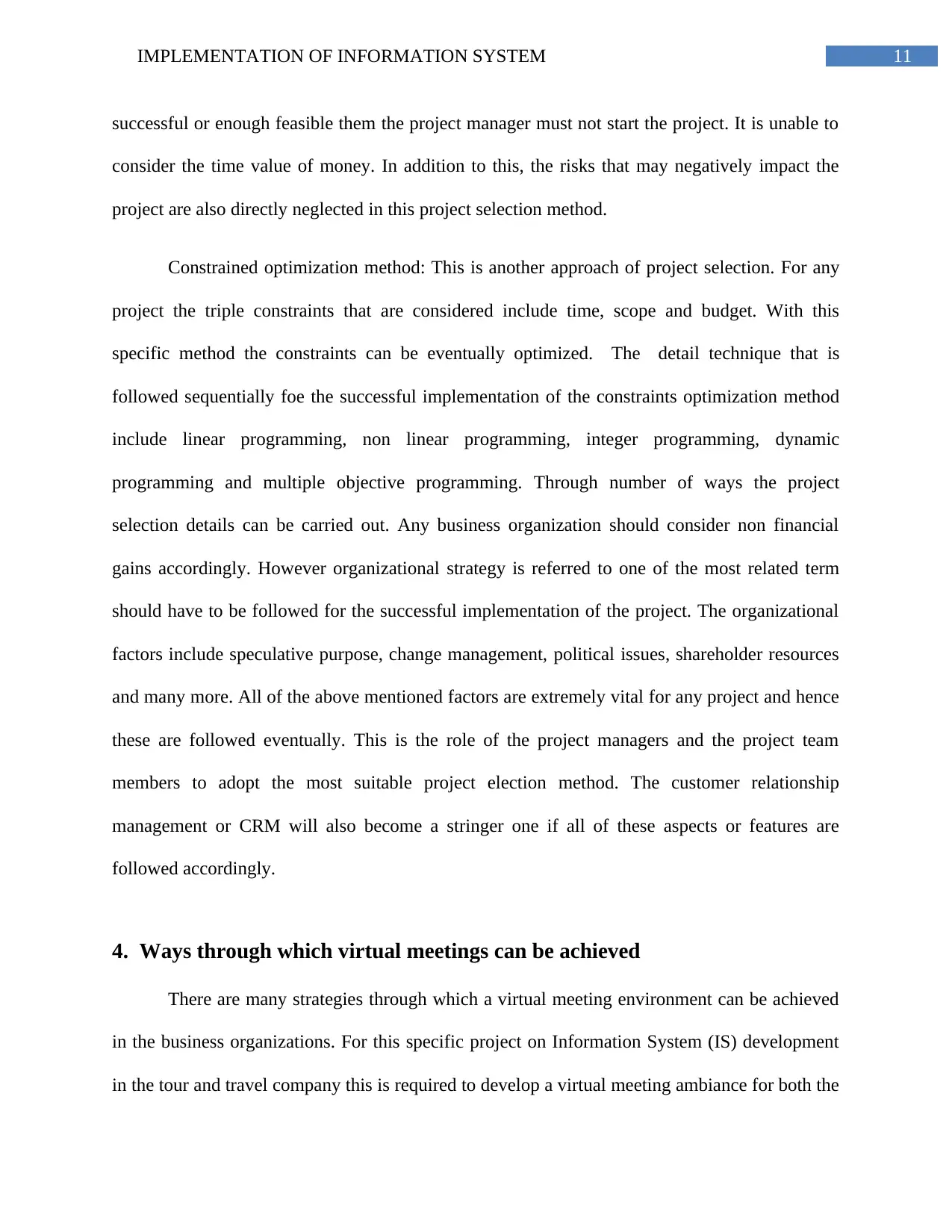
11IMPLEMENTATION OF INFORMATION SYSTEM
successful or enough feasible them the project manager must not start the project. It is unable to
consider the time value of money. In addition to this, the risks that may negatively impact the
project are also directly neglected in this project selection method.
Constrained optimization method: This is another approach of project selection. For any
project the triple constraints that are considered include time, scope and budget. With this
specific method the constraints can be eventually optimized. The detail technique that is
followed sequentially foe the successful implementation of the constraints optimization method
include linear programming, non linear programming, integer programming, dynamic
programming and multiple objective programming. Through number of ways the project
selection details can be carried out. Any business organization should consider non financial
gains accordingly. However organizational strategy is referred to one of the most related term
should have to be followed for the successful implementation of the project. The organizational
factors include speculative purpose, change management, political issues, shareholder resources
and many more. All of the above mentioned factors are extremely vital for any project and hence
these are followed eventually. This is the role of the project managers and the project team
members to adopt the most suitable project election method. The customer relationship
management or CRM will also become a stringer one if all of these aspects or features are
followed accordingly.
4. Ways through which virtual meetings can be achieved
There are many strategies through which a virtual meeting environment can be achieved
in the business organizations. For this specific project on Information System (IS) development
in the tour and travel company this is required to develop a virtual meeting ambiance for both the
successful or enough feasible them the project manager must not start the project. It is unable to
consider the time value of money. In addition to this, the risks that may negatively impact the
project are also directly neglected in this project selection method.
Constrained optimization method: This is another approach of project selection. For any
project the triple constraints that are considered include time, scope and budget. With this
specific method the constraints can be eventually optimized. The detail technique that is
followed sequentially foe the successful implementation of the constraints optimization method
include linear programming, non linear programming, integer programming, dynamic
programming and multiple objective programming. Through number of ways the project
selection details can be carried out. Any business organization should consider non financial
gains accordingly. However organizational strategy is referred to one of the most related term
should have to be followed for the successful implementation of the project. The organizational
factors include speculative purpose, change management, political issues, shareholder resources
and many more. All of the above mentioned factors are extremely vital for any project and hence
these are followed eventually. This is the role of the project managers and the project team
members to adopt the most suitable project election method. The customer relationship
management or CRM will also become a stringer one if all of these aspects or features are
followed accordingly.
4. Ways through which virtual meetings can be achieved
There are many strategies through which a virtual meeting environment can be achieved
in the business organizations. For this specific project on Information System (IS) development
in the tour and travel company this is required to develop a virtual meeting ambiance for both the
⊘ This is a preview!⊘
Do you want full access?
Subscribe today to unlock all pages.

Trusted by 1+ million students worldwide
1 out of 15
Related Documents
Your All-in-One AI-Powered Toolkit for Academic Success.
+13062052269
info@desklib.com
Available 24*7 on WhatsApp / Email
![[object Object]](/_next/static/media/star-bottom.7253800d.svg)
Unlock your academic potential
Copyright © 2020–2025 A2Z Services. All Rights Reserved. Developed and managed by ZUCOL.



